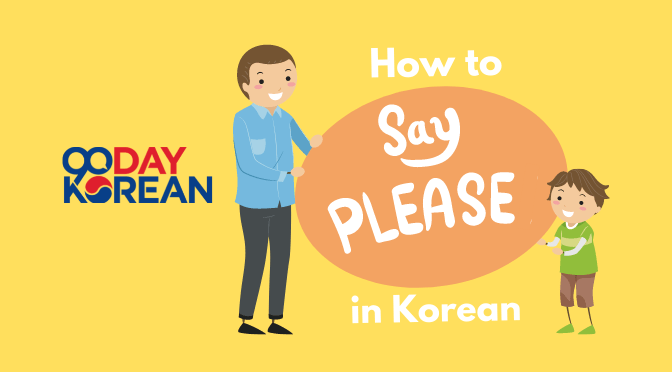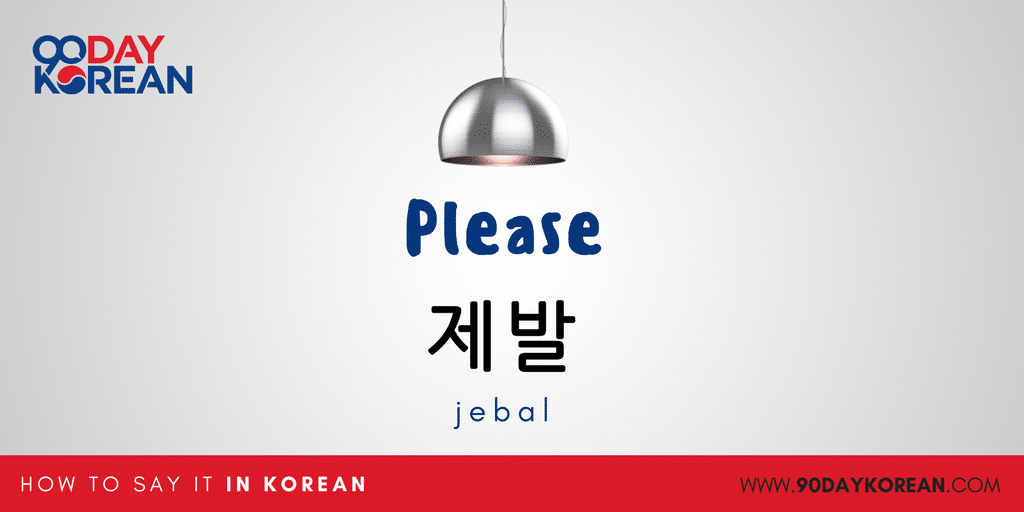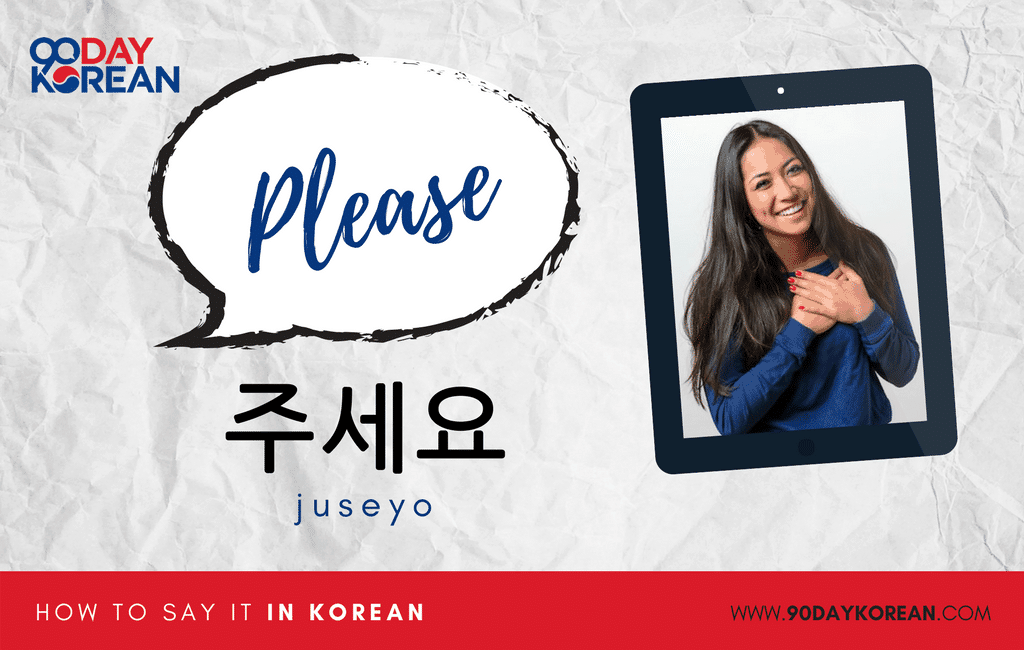How to Say to a Customer Come Again in Korean Ipp
In this article, you lot volition learn how to say "please" in Korean. Regardless of whether people are native speakers of a linguistic communication or speaking a foreign i, information technology is always best to be polite. One way to be polite is to say the word "please." Firstly, how "please" is used in Korean is very different from how it is used if you speak English (Here is a scrap of background).

For starters, there are two different ways of maxim please. This article focuses on the Korean word used for making requests. Yous have probably heard this phrase in a Thousand-drama or perhaps Korean song. Sample Korean phrases are besides included for each discussion so you can practice reading them too.
We've also created a Costless PDF version of this lesson that y'all can take with you on the get. Check information technology out below:
Contents
- 1 How to say "Please" in Korean
- 2 Formal "Please" in Korean
- 2.one 1. 주십시오 (jusipsio)
- two.2 2. 주시기 바랍니다 (jusigi baramnida)
- 3 Standard "Please" in Korean
- iii.1 one. 주세요 (juseyo)
- three.two 2. 주시겠어요 (jusigesseoyo)
- 4 Informal "Please" in Korean
- 4.1 1. 줘 (jwo)
- five The pregnant of 제발 (jebal) in Korean
- vi A Give-and-take of Circumspection Nearly Romanization
How to say "Please" in Korean
There isn't a directly translation for "please" in English into Korean. The politeness in "please" is added into expressions and grammar by using special grammatical forms and vocabulary.
Withal, for simplicity, nosotros'll cover one of the common ways to say "please" in Korean when asking for requests.
The Korean equivalent of "please give" is based on the verb 주다 (juda), pregnant "to give."
How to Say PLEASE Requite ME in Korean | 90 Day Korean
Using 주다 (juda) with a noun, for case, saying "java please" is unproblematic plenty. However, if you want to employ it with a verb, such as "buy this please" or "go there, please," you demand to change the verb as follows:
사다 (sada | to buy) > 사 주다 (sa juda)
가다 (gada | to go) > 가 주다 (ga juda)
돕다 (dopda | to help) > 도와 주다 (dowa juda)
하다 (hada | to do) > 해 주다 (hae juda)
Formal "Delight" in Korean
i. 주십시오 (jusipsio)
This starting time word for "please" is the highest level of saying "please" that you tin can utilize. This polite ending in a judgement is something that you might hear during a speech or a news report.
Example:
잠시만 기다려주십시오 (jamsiman gidaryeojusipsio)
Please wait a moment.
ii. 주시기 바랍니다 (jusigi baramnida)
A similar phrase that you might hear (particularly in announcements) is:
–시기 바랍니다 (sigi baramnida)
Its meaning is slightly different from "please" in the regular sense, so be careful when using it.
Example:
안전선 뒤로 물러나 주시기 바랍니다 (anjeonseon dwiro mulleona jusigi baramnida)
Please step back backside the condom line.
Can't read Korean withal? Click here to learn for free in near 60 minutes!
Standard "Please" in Korean
one. 주세요 (juseyo)
The usual way of proverb "please" in Korean is 주세요 (juseyo). You can apply information technology in most situations, for case, ordering nutrient in a restaurant or request a taxi driver to take you to the railroad train station.
Examples:
돼지갈비 2인분 주세요 (dwaejigalbi i inbun juseyo)
Two portions of pork ribs, please.
서울역으로 가 주세요 (seoullyeogeuro ga juseyo)
Get to Seoul Station, please.
2. 주시겠어요 (jusigesseoyo)
This version is standard but slightly more polite.
If yous are speaking to somebody older than y'all or meeting somebody for the get-go time, you tin also use this expression if you desire to be more than polite.
Case:
좀 도와 주시겠어요? (jom dowa jusigesseoyo)
Volition you assistance me, delight?
Informal "Please" in Korean
1. 줘 (jwo)
This informal catastrophe in a judgement can be used with people who are very close to you and of a like or younger age than you.
Example:
아이스크림 사 줘 (aiseukeurim sa jwo)
Buy me water ice cream, please.
What'south the difference between 주세요 and 제발 when saying "please" in Korean?
The meaning of 제발 (jebal) in Korean
What does "jebal" mean? This is some other discussion that means "please" in Korean is 제발 (je-bal). It is used when pleading or begging for something or making a strong asking.

Case:
제발, 제발 아빠한테 말하지 마세요. (jebal, jebal appahante malhaji maseyo)
Delight, please, don't tell my begetter.
제발 날 떠나지 마! 미안해! (jebal nal tteonaji ma! mianhae!)
Pleasedon'tleaveme! I'm sorry!
A Give-and-take of Caution Well-nigh Romanization
Nosotros've added in the Romanization for all of these words to help with pronunciation. However, nosotros recommend that y'all effort to move on to reading comfortably in Hangul (the Korean alphabet), as this will improve your pronunciation and your reading skills. It will too help you detect patterns in words, which will atomic number 82 yous to improve the charge per unit at which you larn Korean words and grammar points.
Y'all tin can download a costless guide to learn the Korean alphabet in about an hour here.
Learning vocabulary words is a corking style to aid y'all learn Korean basics, only your language learning volition simply really take off one time you get-go attempting to accept conversations in Korean. Have a await at our costless list of Korean phrasesor our full Korean grade for all the help you demand when studying Korean.
Add "please" in our sentences if it'southward needed to make them sound more polite and nice. Whether you're asking for something or would want to say "be conscientious" in Korean to your close friend, it's improve to too say "please". You'll besides often hear these words in K-dramas or Kpop songs. Now you know how to say "please" in Korean, get ahead and ask for some favors. Just don't forget to say "cheers" after!
Source: https://www.90daykorean.com/please-in-korean/



0 Response to "How to Say to a Customer Come Again in Korean Ipp"
ارسال یک نظر